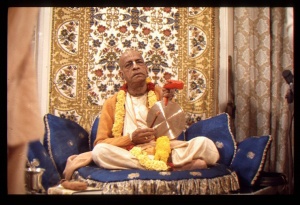CC Madhya 25.206 (1975): Difference between revisions
(Vanibot #0027: CCMirror - Mirror CC's 1996 edition to form a basis for 1975) |
(Vanibot #0020: VersionCompareLinker - added a link to the Version Compare feature) |
||
| Line 2: | Line 2: | ||
<div style="float:left">'''[[Sri Caitanya-caritamrta (1975)|Śrī Caitanya-caritāmṛta (1975)]] - [[CC Madhya (1975)|Madhya-līlā]] - [[CC Madhya 25 (1975)|Chapter 25: How All the Residents of Vārāṇasī Became Vaiṣṇavas]]'''</div> | <div style="float:left">'''[[Sri Caitanya-caritamrta (1975)|Śrī Caitanya-caritāmṛta (1975)]] - [[CC Madhya (1975)|Madhya-līlā]] - [[CC Madhya 25 (1975)|Chapter 25: How All the Residents of Vārāṇasī Became Vaiṣṇavas]]'''</div> | ||
<div style="float:right">[[File:Go-previous.png|link=CC Madhya 25.205 (1975)|Madhya-līlā 25.205]] '''[[CC Madhya 25.205 (1975)|Madhya-līlā 25.205]] - [[CC Madhya 25.207 (1975)|Madhya-līlā 25.207]]''' [[File:Go-next.png|link=CC Madhya 25.207 (1975)|Madhya-līlā 25.207]]</div> | <div style="float:right">[[File:Go-previous.png|link=CC Madhya 25.205 (1975)|Madhya-līlā 25.205]] '''[[CC Madhya 25.205 (1975)|Madhya-līlā 25.205]] - [[CC Madhya 25.207 (1975)|Madhya-līlā 25.207]]''' [[File:Go-next.png|link=CC Madhya 25.207 (1975)|Madhya-līlā 25.207]]</div> | ||
{{CompareVersions|CC|Madhya 25.206|CC 1975|CC 1996}} | |||
{{RandomImage}} | {{RandomImage}} | ||
==== TEXT 206 ==== | ==== TEXT 206 ==== | ||
<div class="verse"> | <div class="verse"> | ||
:duḥkhī vaiṣṇava | :duḥkhī vaiṣṇava dekhi' tāṅre karāna bhojana | ||
:gauḍīyā āile dadhi, bhāta, taila-mardana | :gauḍīyā āile dadhi, bhāta, taila-mardana | ||
</div> | </div> | ||
| Line 18: | Line 17: | ||
<div class="synonyms"> | <div class="synonyms"> | ||
duḥkhī vaiṣṇava—a poverty-stricken Vaiṣṇava; | duḥkhī vaiṣṇava—a poverty-stricken Vaiṣṇava; dekhi'-seeing; tāṅre—to him; karāna bhojana—gives food for eating; gauḍīyā āile—when a Bengali Vaiṣṇava came to Mathurā; dadhi—yogurt; bhāta—cooked rice; taila-mardana—massaging mustard oil on the body. | ||
</div> | </div> | ||
| Line 32: | Line 31: | ||
<div class="purport"> | <div class="purport"> | ||
There is a special reference for the maintenance of Bengali Vaiṣṇavas. A Gauḍīya Vaiṣṇava is a Bengali Vaiṣṇava. Most of the devotees of Lord Caitanya at that time were Gauḍīyas and Oriyās, inhabitants of Bengal and Orissa. There are still many hundreds | There is a special reference for the maintenance of Bengali Vaiṣṇavas. A Gauḍīya Vaiṣṇava is a Bengali Vaiṣṇava. Most of the devotees of Lord Caitanya at that time were Gauḍīyas and Oriyās, inhabitants of Bengal and Orissa. There are still many hundreds and thousands of disciples in Bengal and Orissa. Bengalis are habituated to eating cooked rice as their staple food. When they went to Mathurā in the North, they found that the people generally ate chapatis or roṭi made of wheat. The Bengalis could not digest this food because they were used to cooked rice. Therefore as soon as Subuddhi Rāya saw a Bengali Vaiṣṇava arriving in Mathurā, he would try to supply him with cooked rice. Bengalis are also accustomed to taking a massage with mustard oil. In any case, Subuddhi Rāya wanted to serve the Vaiṣṇavas according to their needs. Therefore he would supply yogurt to ease the digestion of food eaten in Mathurā, particularly the wheat-made chapatis and roṭi. | ||
</div> | </div> | ||
Latest revision as of 16:20, 27 January 2020

A.C. Bhaktivedanta Swami Prabhupada
TEXT 206
- duḥkhī vaiṣṇava dekhi' tāṅre karāna bhojana
- gauḍīyā āile dadhi, bhāta, taila-mardana
SYNONYMS
duḥkhī vaiṣṇava—a poverty-stricken Vaiṣṇava; dekhi'-seeing; tāṅre—to him; karāna bhojana—gives food for eating; gauḍīyā āile—when a Bengali Vaiṣṇava came to Mathurā; dadhi—yogurt; bhāta—cooked rice; taila-mardana—massaging mustard oil on the body.
TRANSLATION
Subuddhi Rāya used to spend his savings to supply yogurt to Bengali Vaiṣṇavas who came to Mathurā. He also gave them cooked rice and oil massages. When he saw a poverty-stricken Vaiṣṇava, he would use his money to feed him.
PURPORT
There is a special reference for the maintenance of Bengali Vaiṣṇavas. A Gauḍīya Vaiṣṇava is a Bengali Vaiṣṇava. Most of the devotees of Lord Caitanya at that time were Gauḍīyas and Oriyās, inhabitants of Bengal and Orissa. There are still many hundreds and thousands of disciples in Bengal and Orissa. Bengalis are habituated to eating cooked rice as their staple food. When they went to Mathurā in the North, they found that the people generally ate chapatis or roṭi made of wheat. The Bengalis could not digest this food because they were used to cooked rice. Therefore as soon as Subuddhi Rāya saw a Bengali Vaiṣṇava arriving in Mathurā, he would try to supply him with cooked rice. Bengalis are also accustomed to taking a massage with mustard oil. In any case, Subuddhi Rāya wanted to serve the Vaiṣṇavas according to their needs. Therefore he would supply yogurt to ease the digestion of food eaten in Mathurā, particularly the wheat-made chapatis and roṭi.